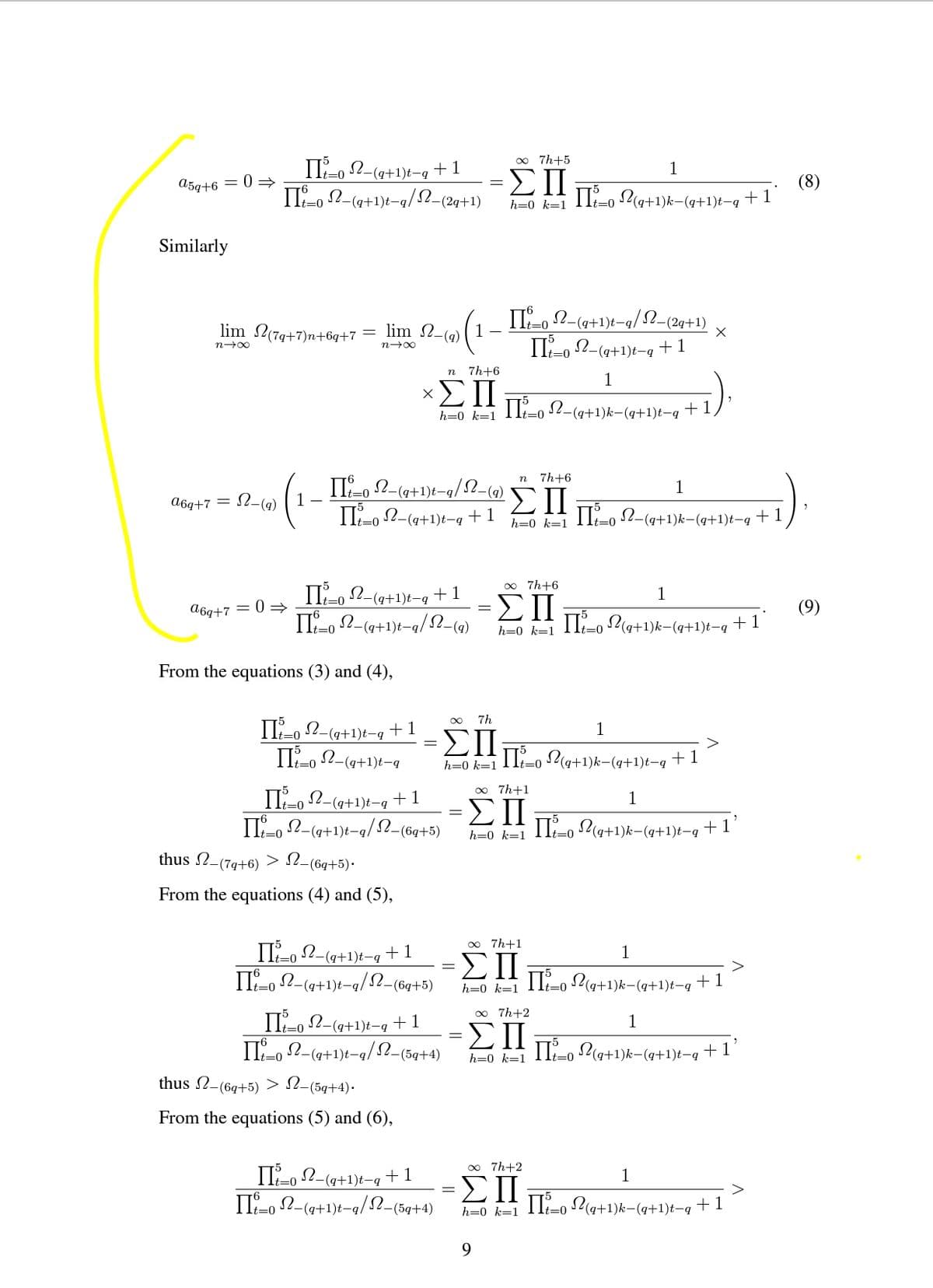05q+6 = 0⇒> Similarly €6q+7 = Ω-(g) lim Ω(7q+7)n+6a+7 818 a6q+7 Πο Ω_(q+1)t-q +1 =0 t=0 (₁ 1 = 0⇒> - (g+1)t-q/ -(2q+1) lim Ω(q) 1 η-100 t=0 = ΠΩ(q+1)t-q + 1 ΠΩq+1)t-q/Ω-(9) – - n 7h+6 ×ΣΠ h=0 k=1 0 7h+5 ΣΠ h=0 k=1 m ΠoΩ_(q+1)t-q/Ω (q) ΠΩ-(a+1)t-q + 1 ΠΩq+1)t-q/Ω—(2q+1) Πο Ω(q+1)t-q +1 t=0 1 ΠoΩ(q+1)k-(q+1)t-q + t=0 1 Πο Ω(q+1)k-(a+1)t-q + 1 Th+6 ΣΠ h=0 k=1 Ω 1 (q+1)k-(q+1)t-q + 1 0 7h+6 1 ΣΠ 2014 ΠΩq+1)k-(a+1)t-q + 1 (8) (9)
05q+6 = 0⇒> Similarly €6q+7 = Ω-(g) lim Ω(7q+7)n+6a+7 818 a6q+7 Πο Ω_(q+1)t-q +1 =0 t=0 (₁ 1 = 0⇒> - (g+1)t-q/ -(2q+1) lim Ω(q) 1 η-100 t=0 = ΠΩ(q+1)t-q + 1 ΠΩq+1)t-q/Ω-(9) – - n 7h+6 ×ΣΠ h=0 k=1 0 7h+5 ΣΠ h=0 k=1 m ΠoΩ_(q+1)t-q/Ω (q) ΠΩ-(a+1)t-q + 1 ΠΩq+1)t-q/Ω—(2q+1) Πο Ω(q+1)t-q +1 t=0 1 ΠoΩ(q+1)k-(q+1)t-q + t=0 1 Πο Ω(q+1)k-(a+1)t-q + 1 Th+6 ΣΠ h=0 k=1 Ω 1 (q+1)k-(q+1)t-q + 1 0 7h+6 1 ΣΠ 2014 ΠΩq+1)k-(a+1)t-q + 1 (8) (9)
Algebra & Trigonometry with Analytic Geometry
13th Edition
ISBN:9781133382119
Author:Swokowski
Publisher:Swokowski
Chapter9: Systems Of Equations And Inequalities
Section9.10: Partial Fractions
Problem 17E
Related questions
Question
Show me the steps of determine yellow and information is here step by step

Transcribed Image Text:In this work, we deal with the following nonlinear difference equation
2m-(7g+6)
1+I-o 2m-(q+1)t-q
Im+1
т %3D 0, 1, ...,
(1)
3D0
where N-(7g+6),
(7q+5), ·…
-1, 2o E (0, 0) is investigated.
(e) If (79+7)n+(t–1)q+t → a(t-1)q+t 7 0 then N(7g+7)n+6q+7 + 0 as n → o,
If L(74+7)n+tq+t → arg+t #0 then (79+7)n+7g+7 →0 as n → o. t =1,6.

Transcribed Image Text:00 7h+5
II-o 2-(a+1)t–q +1
II-, 2-(a+1)t-q/2-(2g+1)
1
ΣΠ
h=0 k-1 11-0 (q+1)k-(q+1)t-q
A5g+6 =
0=
(8)
+1
Similarly
II-, 2-(a+1)t-q/S2-(2q+1)
lim 2(7g+7)n+6q+7
= lim 2-(9)
1
Il-0 2-(a+1)t-q +1
n00
7h+6
n
1
xΣΠ
2-(a+1)k-(q+1)t-q
+1
h=0 k=1
II, 2-(9+1)t-q/2-(4) I
7h+6
1
ΣΠ
II-0 2-(a+1)k-(q+1)t-q +1
A6q+7 =
IT-o 2-(a+1)t-g +1
Lt=0
h=0 k=1
Lt=0
0o 7h+6
II-o 2-(q+1)t-ą +1
II-o 2-(a+1)t-q/2-(a)
1
-ΣΠ
t=0
A6g+7 = 0 =
(9)
II-o P(a+1)k-(q+1)t-q +1
h=0 k=1
From the equations (3) and (4),
7h
+1
1
-(q+1)t-q
TI-o 2-(q+1)t-q
2II Lat+1)k–(q+1)t-q + 1
>
h=0 k=1
=0
o 7h+1
II-, 2-(a+1)t-q+1
IT-o 2-(a+1)t-q/S2-(6q+5)
1
ΣΠ
t=D0
IT-o P(a+1)k-(4+1)t-q +1
h=0 k=1
thus 2-(7g+6) > S2-(6q+5)·
From the equations (4) and (5),
00 7h+1
II-, 2-(4+1)t-q+I
II-0 2-(a+1)t-q/S2-(6q+5)
1
ΣΠ
%3D0
IT-o P(g+1)k-(q+1)t-q
>
+1
t=0
h=0 k=1
13D0
00 7h+2
II-o 2-(9+1)t-q+1
II-, 2-(a+1)t-q/2-(5q+4)
1
-ΣΠ
0=
IT-o Pla+1)k-(q+1)t-q+1"
h=0 k=1
thus 2-(69+5) > S2–(5q+4)·
From the equations (5) and (6),
00 7h+2
II-o 2-(a+1)t-q+1
II-, 2-(a+1)t-q/2-
1
ΣΠ
>
-(5q+4)
11-0 P(a+1)k-(q+1)t-q + 1
=0
h=0 k=1
9.
Expert Solution
This question has been solved!
Explore an expertly crafted, step-by-step solution for a thorough understanding of key concepts.
Step by step
Solved in 5 steps

Recommended textbooks for you

Algebra & Trigonometry with Analytic Geometry
Algebra
ISBN:
9781133382119
Author:
Swokowski
Publisher:
Cengage

Algebra & Trigonometry with Analytic Geometry
Algebra
ISBN:
9781133382119
Author:
Swokowski
Publisher:
Cengage